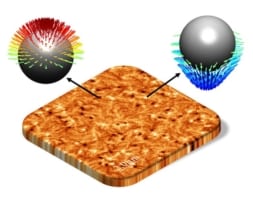Piezoelectric materials are widely employed as transducers and sensors in a variety of applications, including ultrasound medical imaging systems. Researchers have now nearly doubled the performance of a class of piezoelectrics, known as relaxor ferroelectrics, which were discovered 20 years ago, by adding trace amounts of the element samarium (Sm) to them. The rare-earth doping technique, which appears to increase local structural heterogeneity in the crystals, could be a general strategy for enhancing the piezoelectricity of these materials.

The discovery of relaxor ferroelectric single crystals, such as Pb(Mg1/3Nb2/3)O3-PbTiO3 (PMN-PT) and Pb(Zn1/3Nb2/3)O3-PbTiO3 (PZN-PT), was a milestone achievement in ferroelectric research, explain the researchers of Xi’an Jiaotong University in China, Pennsylvania State University in the US and the University of Wollongong in Australia. These materials, which have been optimized over time, have very high piezoelectric coefficients (the amount of charge generated for each unit of force) of 1200 to 2500 picocoulombs per newton.
Although these materials far outperform mainstay piezoelectrics, such as lead zirconate titanate ceramics, researchers have had a hard time improving the properties of PMN-PT and PZN-PT further because it has proven difficult to grow single crystals of the materials with uniform properties.
The Xi’an Jiaotong-Penn State-Wollongong team has now grown Sm-doped PMN-PT singe crystals that boast piezoelectric coefficients ranging from 3400 to 4100 picocoulombs per newton.
Enhanced local structural heterogeneity
The researchers, reporting their work in Science, imaged small volumes of the PMN-PT structure (about 20 x 20 unit cells, or around 40,000 atoms). Thanks to these and first-principles calculations, they showed that the giant piezoelectric properties come from the fact that the Sm3+ dopant enhances local structural heterogeneity within the crystals. “What is more, the trace dopant magically offsets the phase variation induced by Ti from the B-site component of the crystals, so making them more uniform,” they explain.
There are only around 50 Sm atoms present in the volume of sample imaged, which corresponds to a doping of one Sm atom per 1000 atoms of the PMN-PT crystal structure. This is enough, however, to double the material’s piezoelectric coefficient.

Perovskites perform well under pressure
The effect might be mediated by nanoscale strain fluctuations in the material, writes Jiří Hlinka of the Institute of Physics of the Czech Academy of Sciences in a related Perspective article. “These intriguing findings not only represent good news for the designers of electromechanical transducers and low-field actuators but also raise questions about the origin and limits of the distinctive piezoelectric performance of the PMN-PT family of crystals,” he says.
The crystals could find use in various room-temperature piezoelectric applications, say the researchers, and especially in high-frequency medical imaging transducers and low field-driven actuators. Since the new doping technique works on as-grown PMN-PT crystals, it should help decrease the cost of the final devices and reduce material waste.



